Painting the walls in the bathroom: interesting ideas, design and recommendations
Some people tend to consider this type of work, like painting the walls in the bathroom, as a budget option. In part they are right. But only if it is planned to be carried out in order to give the room a more attractive appearance. But if you make a little more effort in terms of surface preparation, plus use your imagination, then it is quite possible to make the bathroom very attractive. In addition, modern materials for painting today are of such high quality that they make it possible to obtain surfaces that are not afraid of dampness and moisture. But it is precisely the influence of these factors that is most exposed to such a room as a bathroom. carried out in it using the right material and in compliance with the necessary technology, and even made according to your own design project, as a result, will allow you to get a functional and extremely beautiful room. Which, by the way, will be no worse than that finished with ceramic tiles. Of course, you will have to work hard. Do not think that it is enough to wave the roller for a couple of hours and - voila! - you can admire the work. The process is also quite lengthy, especially if the home master intends not only to use the renovated bathroom for more than one year, but also to show off his abilities to friends and family. And it requires a thorough approach. We, for our part, intend to make his task somewhat easier by talking about how the walls in the bathroom are painted. What needs to be done for this, what work to do, how to choose the right material, plus a few original design ideas - you will find all this in our review.
General principles
Painting the walls in the bathroom is the final stage of a rather long process, which consists of careful preparation of the base and a competent approach to the choice of material. At the same time, it must be remembered that paint is not a tile, you cannot hide defects with it, rather, on the contrary, it will only emphasize them. Therefore, the walls should end up being almost perfectly even and as smooth as possible. As for the paint itself, it will not work to buy the first one you like, if only because it must be suitable for the chosen purpose, that is, it must be resistant to moisture and dampness. Perhaps, with the choice of it and start. 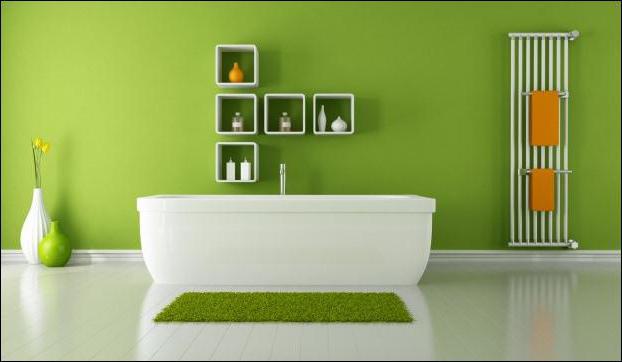
Bathroom paint
As a rule, everyone first of all pays attention to the so-called water emulsion. This is a fairly common option used for this type of repair, such as painting the walls in the bathroom. But! The only advantage of this material is its cheapness. There is nothing else good in such paint, as it will not withstand frequent washing and will quickly lose its attractive appearance. Therefore (for the sake of the same notorious economy), it is best to use it only on the ceiling, where water, as a rule, gets the least. For walls, it is recommended to purchase acrylic or both of these varieties are moisture-proof, but have a "breathing structure", so that the walls painted with them are not susceptible to fungus and are perfectly washed. If the condition of the wallet allows you to “roam around”, it is recommended to purchase silicone or this material is quite expensive, however, the walls covered with it will delight the owners for many years with a magnificent appearance, ease of maintenance, and excellent performance. 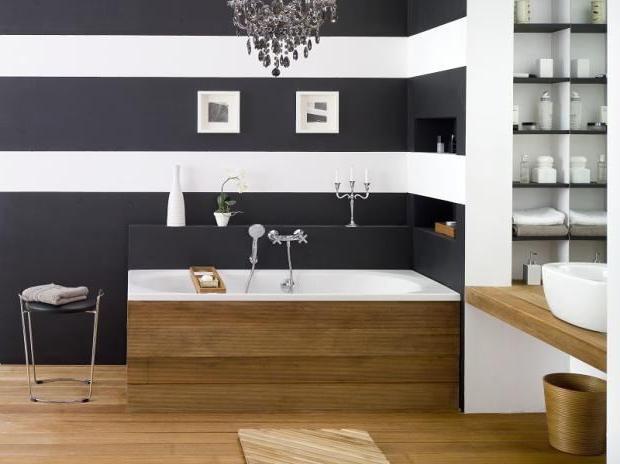
Matt or gloss?
Bathroom wall paint can be matte or glossy. What to choose? There is only one criterion here - what is more to the liking of the owner. If you want to have a shiny surface - get a glossy paint. Want a discreet intelligent coating - buy matte. Consider only one thing: glossy painting requires a perfectly smooth surface, as even the slightest defects are visible on it.
Color
When painting the walls in the bathroom, the design is no less important than the preparatory work. We will talk about the very ideas of decorating this room later, at this stage I would like to note the following. Whatever design is chosen, it will in any case require the presence of a colored coloring composition. It is possible that not even one species. How to get the desired shade? Most often, they do it simply: they get white paint as a base and several bottles of color, the addition of which allows you to achieve the desired shade. But! This is really convenient, but such compositions, unfortunately, are not particularly resistant. Over time, the shade loses its brightness, stains appear on the surface from frequent washing, which causes the appearance of the room to suffer. Therefore, it is best to purchase a ready-made composition of the desired shade. If one could not be found, since the design of painting the walls of the bathroom requires a special color (or even several), you can use the services of companies that will tint with white paint, but using special computer technology, and not by simply adding color by eye. By the way, the latter option is most preferable if complex painting of the walls in the bathroom is expected, using two or more shades, say, of the same color. 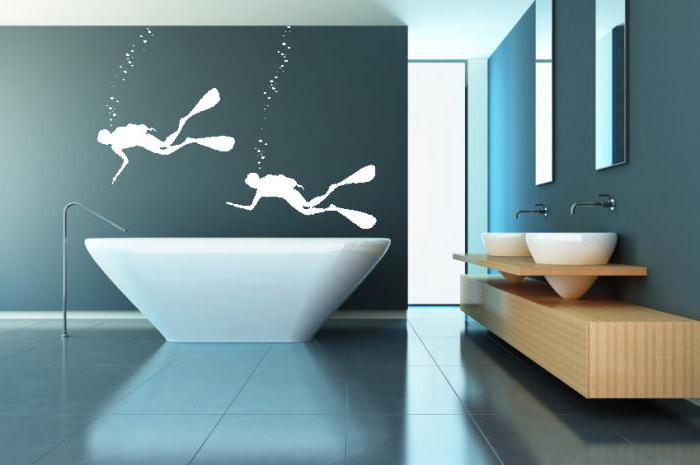
Preparing bathroom walls for painting
By and large, it is no different from that carried out for any other premises. The main condition is that the surface must be even and smooth. Therefore, the first thing to do is to get rid of the old coating (oilcloth, oil paint, whitewash, tiles, etc.). Then you need to evaluate the walls. It is possible that you will first need to level them with plaster, if they are already very uneven. If the surface differences are quite tolerable, then this process can be omitted, large defects can be repaired with plaster, and the surface itself can be leveled by repeated puttying. Remember: after each layer, it is advisable to carefully prime the surface. As for the last, finishing layer, here we must try to make the wall as smooth as possible. In addition, the putty mixture should be only acrylic. A smooth surface can be achieved by sanding the finish layer with fine sandpaper or a mesh, correcting small defects in the course of action by adding putty. The walls in the bathroom for painting are primed several times, and at intervals of at least six hours and always using a primer that contains antifungal additives. 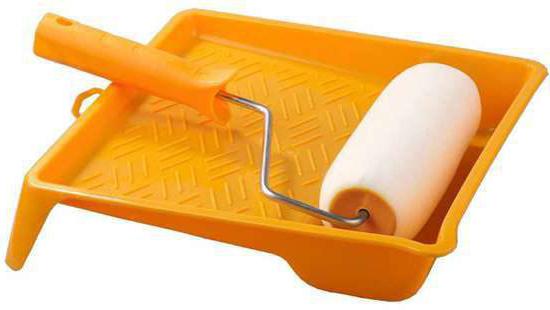
Preparing the bathroom walls for painting is only half the battle. Next comes the staining process itself. Ideally, it would be nice to have a spray gun. With him, and the work argues, and the composition lies on the surface evenly. But not everyone has it. Therefore, in case of its absence, it is best to use a brush and roller during the staining process. The first is applied in the corners, and the second - on a flat surface. In addition, in places where color transitions are planned (between walls and ceilings, for example), it is advisable to use which will allow you to paint accurately. You need to paint in two layers. The first is applied in the vertical direction, and the second in the horizontal direction. As for paint consumption, you need to rely on the fact that one liter can cover no more than one "square" of the surface. Such calculations are especially relevant in cases where it is planned to carry out staining in several shades and with a tinted composition, since, in case of its shortage, it will be quite problematic to achieve exactly the same color a second time. 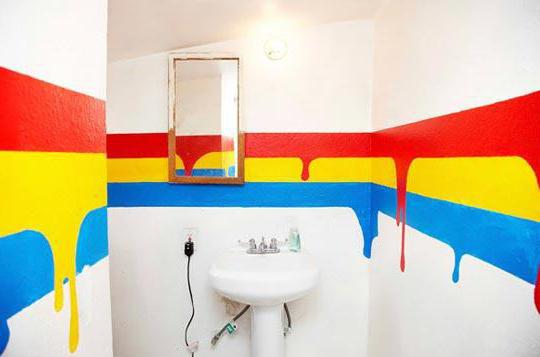
A color scheme
Even if you make a white ceiling, and the walls, albeit plain, but bright, it will already be good. But the decor of the bathroom will be much more interesting if you take not one, but several shades. Looks great combination of neutral colors - black and white, for example. You can also apply a combination of shades of pastel cold tones - mint and blue. You can also apply the gradient method - the use of the same color, but shades of different intensity. Sometimes a combination of contrasting shades justifies itself - orange and blue, yellow and black, etc. In general, the choice is rich. The only thing to consider is that it is undesirable to paint small rooms in dark colors - this will make them look even smaller.
stripes
Stripes look great on the walls, both vertical and horizontal. They can also be made multi-colored, or you can first paint the entire surface with one color, and then apply stripes of darker tones of the same shade. 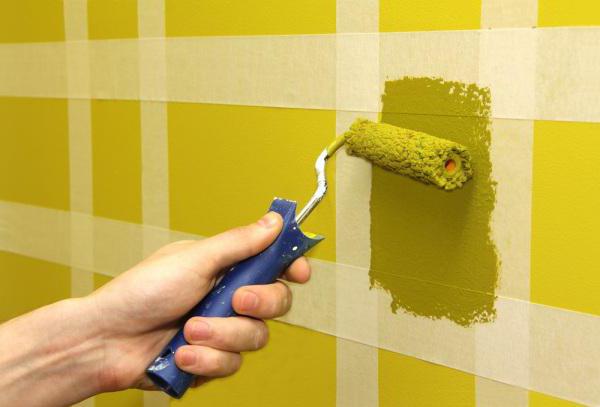
Panels
Instead of stripes, you can make wider inserts according to the main color - the so-called panels, in the form of squares, rectangles. By the way, in order for the borders of the transition to turn out to be even, they must be separated with the same masking tape. Well, if it didn’t work out, it doesn’t matter either. You can stick plastic borders around the edges, having previously painted them.
accents
When repairs are being made in a room such as a bathroom, wall painting can also be done using the accent method. For example, make all the walls soft pastel shades, and paint one, the most prominent, with a completely opposite in tone, but very bright color scheme.
diamonds
It's also a pretty good option. Admittedly, there is a lot of hard work to be done. First you need to paint the wall in the main color, then carry out a thorough marking, then stick masking tape on the borders of each rhombus, and then paint some of the rhombuses with a different shade.
stencils
A great option, and coloring with stencils will not cause any particular difficulties. As for the latter, they can either be purchased at the store or made independently. 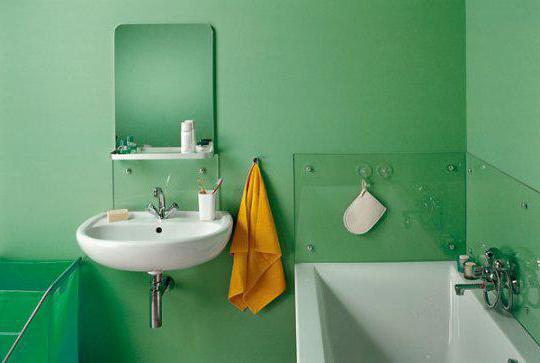
Of course, if you decide to prepare walls for painting in a room such as a bathroom, then one thing should be remembered: no matter how high-quality the chosen paint is, over time, stains from constant exposure to moisture will still appear on it, especially in those places where get water - that is, above the bath itself. To avoid this, you can make a kind of protective apron - for example, attach glass or transparent plastic panels in these places. Or glue mosaic tiles. A good option is special ceramic panels, which today can be easily picked up in stores to match the color of the main decor (that is, paint). And another universal way is to cover already painted walls with waterproof varnish. And then certainly they will not be afraid of any moisture!






